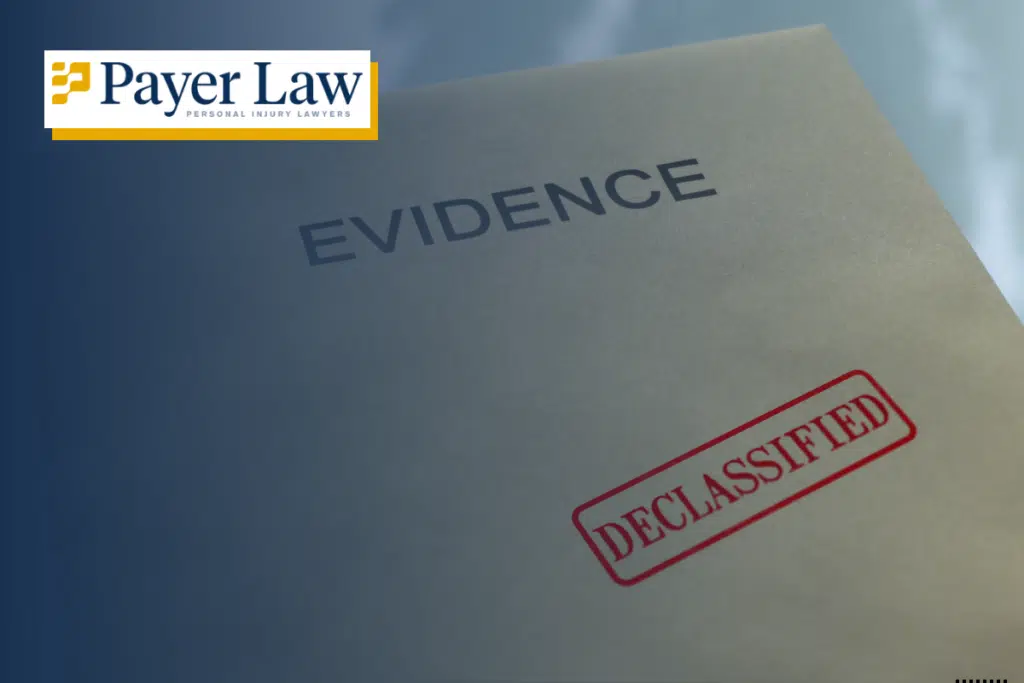
Reviewed by: James D. Payer
In law, it is fair to say that nothing is true unless you can prove it. To prove any assertion, however, you need evidence. But what exactly constitutes evidence? A lawyer at Payer Law Personal Injury Lawyers might answer this question differently than a philosopher would.
In Florida state courts, the Florida Evidence Code determines what evidence is and which evidence is admissible. In federal court, the Federal Rules of Evidence govern.
Types of Evidence
The evidence that you might need to win a personal injury lawsuit comes in many different forms. Following is an explanation of some of the main forms of evidence used in personal injury cases.
Documentary Evidence
Documents can include contracts, bills, medical records, and affidavits, for example. Even the truck accident information contained in a commercial vehicle’s “black box” (event data recorder) constitutes documentary evidence. Digital evidence can constitute documentary evidence.
Physical Evidence
Physical evidence is something “tangible enough to drop on your foot.” It could include a damaged automobile, for example. It could also include a human body if the defendant in a personal injury case demands that the plaintiff submit to an independent medical examination of their injuries.
Even a defective shopping cart can constitute admissible physical evidence if it causes a slip and fall accident.
Testimonial Evidence
You generate testimonial evidence when you speak under oath about relevant matters. You might do this at trial, for example, or you might do it at an out-of-court deposition. The opposing party has the right to cross-examine you and try to discredit your testimony.
Expert Witness Testimony
Expert witnesses are special types of witnesses who can testify on matters they did not personally see, due to their expertise in a particular field. For example, a medical expert witness in a malpractice case might give their opinion on whether the defendant doctor should have ordered a C-section during a difficult delivery.
Demonstrative Evidence
Demonstrative evidence might include, for instance, charts and graphs that an accident reconstruction expert uses to establish a point they are trying to make. Photographs and videos also count as demonstrative evidence.
Restrictions on the Admissibility of Evidence
Not all evidence is admissible, and one of the main jobs of your lawyer is to exclude unfavorable evidence. Following are a few categories of inadmissible evidence.
Irrelevant Evidence
Relevance is an absolute requirement for all kinds of evidence. Although relevant evidence is sometimes excluded, irrelevant evidence can always be excluded.
Evidence for Which the Prejudicial Effect Exceeds the Probative Value
Evidence has a high prejudicial effect if it tends to bias the court one way or another for emotional rather than rational reasons. The meaning of “probative value” is similar to the meaning of “relevance.”
An example of evidence that a court might exclude for this reason is graphic photos of a murder scene, especially if a witness has already described the victim’s injuries.
Evidence of Subsequent Remedial Measures
Suppose someone is injured by an allegedly dangerous condition on your property, and they sue you for damages. You repair the condition while the lawsuit is pending. The opposing party cannot introduce evidence that you repaired the condition to prove that the condition was dangerous in the first place.
The reason for this rule is that if it did not exist, your lawyer would probably advise you not to repair the condition (“They’ll use it against you!”). In this way, a second person might suffer an injury. This rule is a reflection of the fact that the primary purpose of the law is not to punish wrongdoers or even to compensate victims, but to prevent people from suffering injury in the first place.
Hearsay
Hearsay is “an out-of-court statement offered to prove the truth of whatever it asserts.” A police report is hearsay, as it was prepared out of court. Spoken words can also be hearsay. The way to introduce evidence in a police report is to call the officer who wrote it as a witness and question them.
In this way, the opposing party can cross-examine the officer. Naturally, you cannot cross-examine a police report. Note that there are many exceptions to the hearsay rule.
You Don’t Need a Dime To Hire an Orlando Personal Injury Lawyer
To an experienced Orlando personal injury lawyer at Payer Law Personal Injury Lawyers, your claim is your currency. Having a strong claim, in other words, is far more important to a personal injury lawyer than having a lot of money in your bank account.
Even if you’re flat broke, the contingency fee system allows you to pay your legal fees out of your eventual compensation. And if you don’t win, you don’t pay attorney’s fees-–at all. Contact a lawyer for a free consultation at (407) 648-1510 to learn about your options.
Hours: Open 24 hours daily
$27.56
MILLION
VERDICT
Car crash resulting in significant brain injuries
$3.10
MILLION
VERDICT
Jury verdict in ambulance liabilty damage case
$2.25
MILLION
VERDICT
Car accident resulting in
a TBI
$2.00
MILLION
VERDICT
Breathing injuries due to
chemical exposure
$1.65
MILLION
VERDICT
Our clients son was killed by an allegedly drunk driver
$1.25
MILLION
VERDICT
Car accident resulting in lower leg amputation
$1
MILLION
VERDICT
Car accident resulting in multiple facial damages

Injured?
Contact Us Today
Client Reviews
Professional, efficient, helpful, and dedicated to their clients. Lysette West extremely attentive and responsive, answered every question or concern professionally and swiftly. She set my mind at ease during some of the most difficult times I have encountered. Even when I missed an appointment because of a natural disaster. She jumped right into the situation cleared it up and got the ball rolling again in short order. I only wish I was able to call on Payer Law for all my legal issues.
James has a heart for justice and is passionate about helping the ones in need of fair representation. Thank you for your professionalism and confidence in what’s right. Thank you for caring and being there for my mom and our family. God bless.
The staff are courteous and knowledgeable. Chris Payer treats me like family and I know he is fighting for me and my case. I highly recommend Payer Law.


